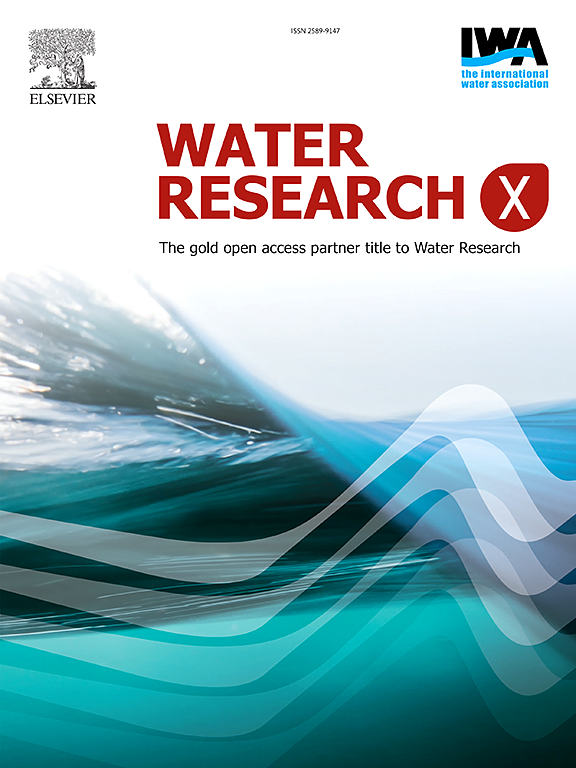Use of the MABR fingerprint soft sensor to control biofilm thickness and optimize hybrid membrane aerated biofilm reactor (MABR) performance
IF 8.2
2区 环境科学与生态学
Q1 ENGINEERING, ENVIRONMENTAL
引用次数: 0
Abstract
Installing commercial membrane-aerated biofilm reactor (MABR) units into existing systems to form hybrid MABRs us ab emerging approach to increase wastewater treatment capacity and enhance nutrient removal due to tightened discharge regulations and growing populations. Biofilm thickness is identified as a critical parameter affecting MABR performance. To monitor biofilm thickness and develop a biofilm thickness control strategy for practical full-scale MABR units, this study develops the MABR fingerprint soft sensor as the linear relationship between off-gas oxygen content (% O2) and bulk ammonia concentration (mg-N/L) under diurnally varying loading conditions. Simulations were conducted to test the implementation of the MABR fingerprint soft sensor in MABR units in a completely mixed tank and MABR units arranged in series. Results indicate that relatively thin biofilms, quantified by a higher numerical value of the MABR fingerprint soft sensor metric, should be maintained for the single-stage hybrid MABRs and in the initial stage for MABRs in series to optimize nitrification and denitrification simultaneously. The MABR fingerprint soft sensor metric can serve as a proactive signal to indicate biofilm thickness changes before noticeable deviations in performance occur. The numerical value of the MABR fingerprint soft sensor metric associated with optimal process performance was found to be relatively consistent over a range of process loadings and operation conditions, including temperature variations, wet weather flow conditions, and varying wastewater characteristics. A general procedure to implement the MABR fingerprint soft sensor to optimize the performance in the large-scale hybrid MABRs is provided.
利用MABR指纹软传感器控制生物膜厚度,优化混合膜曝气生物膜反应器(MABR)的性能
在现有的系统中安装商用膜曝气生物膜反应器(MABR)单元,形成混合型MABR,是一种新兴的方法,可以提高废水处理能力,提高营养去除能力,这是由于排放法规的收紧和人口的增长。生物膜厚度被认为是影响MABR性能的关键参数。为了监测生物膜厚度并为实际的全尺寸MABR装置开发生物膜厚度控制策略,本研究开发了MABR指纹软传感器,作为在日变化负载条件下的烟气氧含量(% O2)和散装氨浓度(mg-N/L)之间的线性关系。通过仿真测试了MABR指纹软传感器在完全混合槽内MABR单元和MABR单元串联上的实现情况。结果表明,单级混合MABR和串联MABR的初始阶段应保持相对较薄的生物膜,以较高的数值量化MABR指纹软测量指标,以同时优化硝化和反硝化。MABR指纹软传感器指标可以作为主动信号,在明显的性能偏差发生之前指示生物膜厚度的变化。与最佳工艺性能相关的MABR指纹软传感器指标的数值在一系列工艺负荷和操作条件下相对一致,包括温度变化、潮湿天气流量条件和不同的废水特性。为了优化大规模混合MABR指纹软传感器的性能,给出了实现MABR指纹软传感器的一般程序。
本文章由计算机程序翻译,如有差异,请以英文原文为准。
求助全文
约1分钟内获得全文
求助全文
来源期刊

Water Research X
Environmental Science-Water Science and Technology
CiteScore
12.30
自引率
1.30%
发文量
19
期刊介绍:
Water Research X is a sister journal of Water Research, which follows a Gold Open Access model. It focuses on publishing concise, letter-style research papers, visionary perspectives and editorials, as well as mini-reviews on emerging topics. The Journal invites contributions from researchers worldwide on various aspects of the science and technology related to the human impact on the water cycle, water quality, and its global management.
 求助内容:
求助内容: 应助结果提醒方式:
应助结果提醒方式:


